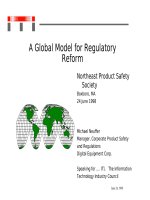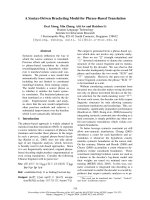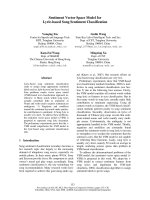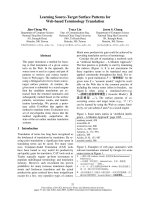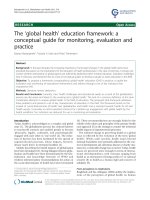A conceptual model for web based construction project management
Bạn đang xem bản rút gọn của tài liệu. Xem và tải ngay bản đầy đủ của tài liệu tại đây (4.9 MB, 198 trang )
A CONCEPTUAL MODEL FOR
WEB-BASED CONSTRUCTION PROJECT MANAGEMENT
LEUNG NGA NA
(B. Arch., Tongji University, China)
A THESIS SUBMITTED
FOR THE DEGREE OF MASTER OF SCIENCE
DEPARTMENT OF BUILDING
SCHOOL OF DESIGN AND ENVIRONMENT
NATIONAL UNIVERSITY OF SINGAPORE
2002
ACKNOWLEDGEMENTS
I would like to express my deepest gratitude towards Dr. Chan Swee Lean, my
supervisor, for her excellent advice, guidance, patience, and time, without which this
work would not have been possible. It was a great pleasure and precious experience
working with her.
My sincere appreciation is given to Dr. Wang Shouqing, Dr. George Ofori,
and Dr. Goh Bee Hua, for their excellent guidance, valuable comments in the research
and the academic life.
Also I would like to thank Yang Yiqing, Gao Xia, Liu Yinsheng, and Mao
Zhi, who have devoted tremendous helps to my research adventure. My earnest
gratitude goes to my research fellows – Li Yan, Lin Chao, Peng Zhen, Shi Yuquan,
Song Yan, Wang Yong, and Yang Haishan, whose inspiration and friendship are the
spiritual source of my expedition.
Special thanks are given to my dear family, relatives, and friends for their
endless love and concerns; and Zhan Lezhou for his understanding and
encouragement.
ii
TABLE OF CONTENTS
ACKNOWLEDGEMENTS
TABLE OF CONTENTS
LIST OF FIGURES
LIST OF TABLES
LIST OF ACRONYMS
SUMMARY
ii
iii
vii
ix
x
xi
CHAPTER 1 INTRODUCTION
1.1 RESEARCH BACKGROUND
1.2 RESEARCH PROBLEMS AND RATIONAL
1.3 RESEARCH OBJECTIVES
1.4 RESEARCH SCOPE
1.5 RESEARCH METHODOLOGY
1.6 ORGANIZATION OF THE DISSERTATION
1
1
2
4
4
5
7
CHAPTER 2 LITERATURE REVIEW
2.1 INTRODUCTION
2.2 IT-RELATED PROBLEMS IN THE AEC INDUSTRY
2.2.1 Fragmentation
2.2.2 Data Incompatibility
2.3 INFORMATION INTEGRATION
2.3.1 Managerial Integration
2.3.1.1 Process Redesign
2.3.1.2 Concurrent Engineering
2.3.2 Technical Integration
2.3.2.1 Back-End Integration
2.3.2.2 Front-End Integration
2.4 INTERNETWORKING AND APPLICATION
2.4.1 Internetworking Technology
2.4.1 Internetworking Applications
2.5 STANDARDIZATION
2.5.1 Standard For The Exchange Of Product Model Data
2.5.2 Industry Foundation Classes
2.6 CONCEPTUAL MODELING METHODOLOGIES
2.6.1 The STEP Methodology
2.6.2 The UML Methodology
2.7 EXTENSIBLE MARKUP LANGUAGE
2.7.1 BcXML
2.7.2 AecXML
2.7.3 IfcXML
2.8 SUMMARY
10
10
10
10
12
13
13
14
15
15
16
16
18
18
19
22
22
22
23
24
26
26
27
28
28
29
CHAPTER 3 FUNCTIONAL REQUIREMENTS OF ASPS
3.1 INTRODUCTION
3.2 HISTORY OF ASP DEVELOPMENT
3.3 AS-IS FEATURES
3.4 TO-BE FEATURES
30
30
30
31
34
iii
3.4.1 Time And Cost Considerations
3.4.2 Integration
3.4.3 Intelligent Search For Information
3.4.4 Knowledge Base
3.4.5 Customizability To Persons
3.4.6 Customizability To Projects
3.4.7 Scalability
3.4.8 Others
3.5 ASPS IN SINGAPORE
3.6 ASP BENEFITS
3.6.1 Improved Communication
3.6.2 Reduction On Project Life Cycle Time
3.6.3 Reduction On Cost
3.6.4 Accountability And Records
3.6.5 Gaining Competitive Advantages
3.7 OBSTACLES TO ADOPTION OF ASP
3.7.1 Economic Considerations
3.7.2 Organizational Changes
3.7.3 Lack Of ASP Standards
3.7.4 Other Obstacles
3.8 SUMMARY
35
35
36
36
36
37
37
37
37
38
39
40
41
41
42
43
43
44
45
46
46
CHAPTER 4 EMPIRICAL STUDY OF USER REQUIREMENTS
4.1 INTRODUCTION
4.2 SURVEY METHODOLOGY
4.2.1 Sample
4.2.2 Web-based Survey
4.2.3 Confidentiality
4.2.4 Survey Organization and Design
4.2.5 Technical Details
4.2.6 Survey Distribution
4.2.7 Potential Sources Of Biasness
4.3 DATA ANALYSIS
4.4 OVERALL FINDINGS AND ANALYSIS
4.4.1 Part 1 Respondent Profiles
4.4.2 Part 2 General Use Of IT And Networking
4.4.3 Part 3 Uses Of ASP
4.4.3.1 Acceptance Of ASP
4.4.3.2 Awareness Of ASP
4.4.3.3 Expected Impacts On Time
4.4.3.4 Evaluation Of As-Is Features
4.4.3.5 Evaluation Of To-Be Features
4.4.3.6 Comments On ASP
4.5 SUMMARY
47
47
47
47
48
49
49
52
52
52
54
55
55
56
59
59
61
63
65
66
66
66
CHAPTER 5 CONCEPTUAL MODEL DEVELOPMENT
5.1 INTRODUCTION
5.2 THE UML MODELING METHOD
5.2.1 The UML Modeling Approaches
5.2.2 Use Case Documents
69
69
69
70
73
iv
5.3 MAJOR ACTORS
5.4 THE MAIN USE CASE
5.4.1 Setup Project Service
5.4.2 Setup Project Website
5.4.3 Setup User
5.4.4 Log In
5.4.5 Package Manage Document
5.4.6 Package Manage Workflow
5.4.7 Package Team Communication
5.4.8 Package My Project Place
5.4.9 Administrate Project
5.5 SUMMARY
74
75
76
76
77
78
78
81
84
85
85
86
CHAPTER 6 PROTOTYPING OF REQUEST FOR INFORMATION
6.1 INTRODUCTION
6.2 THE REQUEST FOR INFORMATION SCENARIO
6.3 USE CASES INVOLVED
6.4 EXTENSIBLE MARKUP LANGUAGE
6.4.1 XML In The Scenario
6.4.1.1 Schemas For Response To Request For Information (ReRFI)
6.4.1.2 XML File For The Response To Request For Information
6.4.2 XML Presentation
6.4.3 Schema Mapping Between IfcXML And Document XML
6.4.4 The Integrated Webpages
6.4.5 Applications
6.5 SUMMARY
87
87
87
102
103
104
105
109
109
111
113
115
116
CHAPTER 7 CONCLUSIONS AND RECOMMENDATIONS
7.1 INTRODUCTION
7.2 GENERAL CONCLUSIONS
7.3 IMPLICATIONS
7.4 LIMITATIONS AND RECOMMENDATIONS
117
117
117
119
121
REFERENCES 123
APPENDIX I ASP AS-IS FEATURES
I.1 GENERAL SYSTEM
I.2 DOCUMENT MANAGEMENT
I.3 WORKFLOW MANAGEMENT
I.4 ADMINISTRATION
I.5 USER CENTRIC WORKPLACE
I.6 TEAM COMMUNICATION
I.7 ASP SERVER PERFORMANCE
130
130
130
132
134
135
136
137
APPENDIX II SURVEY QUESTIONNAIRE 139
APPENDIX III THE CONCEPTUAL MODEL
III.1 MAJOR ACTORS
III.2 THE MAIN USE CASE
III.2.1 Setup Project Service
152
152
153
154
v
III.2.2 Setup Project Website
III.2.3 Setup User
III.2.4 Log In
III.3 PACKAGE MY PROJECT PLACE
III.3.1 View What’s New
III.3.2 Manage My Task
III.3.3 Manage My Profile
III.3.3.1 Request For Role Change
III.3.4 Manage Subscription
III.4 PACKAGE MANAGE DOCUMENT
III.4.1 Upload File
III.4.2 Search File
III.4.3 Search Topic
III.5 PACKAGE MANAGE WORKFLOW
III.5.1 Manage Change
III.5.1.1 Manage RFI
III.5.1.2 Manage Variation Order
III.5.2 Manage My Work Package
III.6 PACKAGE TEAM COMMUNICATION
III.6.1 View BBS
III.7 PACKAGE ADMINISTRATE PROJECT
III.7.1 Setup User
154
155
157
158
158
159
160
161
163
164
165
166
167
169
169
170
172
173
174
175
176
176
APPENDIX IV XML DOCUMENTS FOR RERFI
IV.1 HTML FILE OF RERFI
IV.2 XML SCHEMA OF RERFI
IV.3 SOURCE CODES OF RERFI SCHEMA
IV.4 XML FILE OF RERFI
IV.5 SOURCE CODES OF RERFI XML
177
177
179
181
184
185
vi
LIST OF FIGURES
Figure 1.1 Document-Based System: Fragmented Information.
Figure 1.2 DMI System: Multiple Views Of The Same Data.
Figure 1. 3 Flow Chart Denoting The Relationships Among The Chapters And
Appendices.
2
3
8
Figure 2.1 Fragmentation During Project Phases And Among Participants.
Figure 2.2 Hierarchy Of Information Integration.
Figure 2.3 Process Redesign And Return On Investment.
Figure2.4 Configuration Of A Document Management.
Figure 2.5 Components Of The CORENET Project.
Figure 2.6 IFC2x Architecture.
11
13
14
17
21
24
Figure 3.1 Illustration Of Projected Construction Industry Software Evolution.
31
Figure 4.1 Screen Shot of The Survey.
Figure 4.2 Flowchart Of The Web-Based Survey.
Figure 4.3 Type Of Company.
Figure 4.4 Job Duty.
Figure 4.5 Years Of Working Experience.
Figure 4.6 Purpose Of Company Homepage.
Figure 4.7 Access Of Internet.
Figure 4.8 Mean Proportions Of Staff Using IT.
Figure 4.9 Mean Proportions For Document Exchanges.
Figure 4.10 Mean Scales Of IT Effects.
Figure 4.11 Major Benefits Of Using ASP.
Figure 4.12 Major Concerns Of Using ASP.
Figure 4.13 Overall Awareness Of ASPs.
Figure 4.14 Overall Awareness Of Local Services.
Figure 4.15 Mean Scales Of ASP Effects On Time.
Figure 4.16 Evaluation Of ASP As-Is Features In Terms Of Mean Scales.
Figure 4.17 Evaluation Of ASP To-Be Features In Terms Of Mean Scales.
49
51
56
56
56
57
58
58
59
59
60
61
62
62
64
65
66
Figure 5.1 Actor And Use Cases.
Figure 5.2 Activity Diagram.
Figure 5.3 Packages.
Figure 5.4 User Inheritances.
Figure 5.5 Main Use Case.
Figure 5.6 Setup Project Website.
Figure 5.7 Manage Document Inheritance.
Figure 5.8 Manage Document.
Figure 5.9 Upload File.
Figure 5.10 Search File.
Figure 5.11 Search Topic.
Figure 5.12 Package Management Workflow.
Figure 5.13 Manage Change.
Figure 5.14 Workflow Of RFI.
71
72
72
75
76
77
78
78
79
79
81
82
82
83
vii
Figure 5.15 Team Communication.
Figure 5.16 My Project Place.
Figure 5.17 Administrate Project.
84
85
86
Figure 6.1 Original Detail Drawings Of The Parapet.
Figure 6.3 Collaboration Diagram Of The Paper-Based Process.
Figure 6.4 Collaboration Diagram Of The DMI Process.
Figure 6.4 Proposed Detail Drawings Of The Parapet.
Figure 6.5 RFI Created By YS Liu.
Figure 6.6 Part Of RFI Responded By K Foo.
Figure 6.7 Part Of RFI Responded By M Ang.
Figure 6.8 Summary Of RFI.
Figure 6.9 Document Data Exchange.
Figure 6.10 Document Data Exchange Between ReRFI And QFC.
Figure 6.11 Top Level Elements In ReRFI Schema.
Figure 6.12 RFI Complex Type In ReRFI Schema.
Figure 6.13 Response Complex Type In ReRFI Schema.
Figure 6.14 LinkFile Complex Type In ReRFI Schema.
Figure 6.15 ActorSelect Complex Type In ReRFI Schema.
Figure 6.16 XML File Of ReRFI.
Figure 6.17 Information Exchange Architecture Of The DMI System.
88
89
89
93
97
99
99
100
105
105
106
107
108
108
108
110
115
viii
LIST OF TABLES
Table 5.1 Use Case Document Template. 73
Table 6.1 Person, Role And Company .
Table 6.2 Comparison Of Paper-Based And DMI Processes.
Table 6.3 Request For Information Form.
Table 6.4 Part Of The Original Quotation.
Table 6.5 Quotation For Change Form.
Table 6.6 Use Cases Involved In The Dmi Rfi Process.
Table 6.7 Schema Mapping Between Ifcxml And Rerfi Xml.
88
90
94
95
95
103
112
ix
LIST OF ACRONYMS
3D:
AAM:
AEC:
AIC:
AIM:
AP:
ARM:
ASP:
BBS:
CAD:
CASE:
CGI:
CIO:
CORENET:
CSCW:
DMI:
DOM:
EDMS:
GLOBEMEN:
GUI:
HTML:
IAI:
IDEF:
IFC:
IP:
ISDN:
ISO:
ISTforCE:
IT:
NIAM:
OMG:
OOCAD:
PC:
PDA:
QFC:
ReRFI:
RFI:
SDE:
SGML:
SMS:
STEP:
UML:
VO:
W3C:
WAP:
WISPER:
What’s New:
XSD:
XSL:
XSLT:
XML:
3-Dimensioned
Application Activity Model
Architecture, Engineering and Construction
Application Interpreted Constructs
Application Interpreted Model
Application Protocol
Application Reference Model
Application Service Provider
Bulletin Board System
Computer Aided Design / Drafting
Computer Aided Software Engineering
Common Gateway Interface
Chief Information Officer
Construction and Real Estate Network
Computer Supported Collaborative Work
Data Markup Integration
Document Object Model
Electronic Document Management System
Global Engineering and Manufacturing in Enterprise Networks
Graphical User Interface
HyperText Markup Language
International Alliance of Interoperability
ICAM Function Definition Method
Industry Foundation Classes
Internet Protocol
Integrated Service Digital Network
International Standards Organization
Intelligent Services and Tools for Concurrent Engineering
Information Technology
Nijssen's Information Analysis Method
Object Management Group
Object-Oriented Computer-Aided Design / Drafting
Personal Computer
Personal Digital Assistant
Quotation For Change
Response to Request For Information
Request For Information
School of Design and Environment
Standard Generalized Markup Language
Short Message Service
Standard For The Exchange Of Product Model Data
Unified Modeling Language
Variation Order
World Wide Web Consortium
Wireless Application Protocol
Web-based IFC Shared Project EnviRonment
What is new
XML Schema Definition
eXtensibel Stylesheet Language
XSL Transformations
eXtensible Markup Language
x
SUMMARY
Web-based construction project management emerged with the popularity of
the Internet. A Web-based project management system is a restricted network for
project specific collaboration and communication. It supports information sharing,
enables timely communication, and offers dynamic information for decision making.
These solutions are provided by the Application Service Providers (ASPs). ASPs are
commercial portal vendors who offer Web-enabled project management services in
exchange of a certain amount of monthly service fees.
This research aims at proposing a conceptual model of Data Markup
Integration (DMI) system for data exchange among Web-based documents for the
construction project management. The system is able to extract useful data from the
original documents, re-organize the information according to specific tasks and users,
and display in an integrated webpage.
The thesis consists of four parts: collection of ASP features, identification of
user requirements, conceptual modeling, and prototyping.
The study on current Web-based collaboration systems identifies 7 categories of
ASP as-is features: general system; document management; workflow management;
administration; user centric workplace; team communication; and ASP server
performance. These features are, in general, useful. Limitations of the current
systems are information overflow, fragmentation of information, and data
incompatibility, etc. To overcome the limitations, 8 categories of ASP to-be features
are analyzed: time and cost consideration; integration; intelligent search for
xi
xii
information; knowledge base and intelligence; customizability to persons;
customizability to projects; scalability; and others.
The Web-based survey of user requirements in Singapore identified 4
categories of current features as “very useful”: document management; workflow
management; administration; and team communication. These features have been
incorporated in the conceptual model. Also regarded as “very useful” were 4
categories of to-be features: time and cost consideration; integration; intelligent search
for information; and knowledge base. Among these features, integration through data
markup has been incorporated in the research.
A conceptual model of DMI is built up. The model consists of 5 major
packages: my project place; manage document; manage workflow; administrate
project; and team communication. Each package contains some major use cases.
The processes of paper-based and DMI Request For Information (RFI) are
compared to demonstrate the advantages of Web-based collaborations via DMI.
Prototyping the RFI case also demonstrates technical feasibility of implementing the
DMI system. It is found that the DMI process provides the convenience of ready,
complete and integrated information in a timely manner, which helps the users to
make decisions faster and more accurately, so that downstream parties can take
actions faster. It also helps to keep track of the collaboration, reduce data re-
inputting, and minimize errors.
CHAPTER 1 INTRODUCTION
1.1 RESEARCH BACKGROUND
Web-based construction project management emerged with the popularity of
the Internet. The prompt development of commercial Web-based project
management solutions is an industrial response to the fragmentation nature of the
Architectural, Engineering and Construction (AEC) industry.
A Web-based project management system is a restricted network for project
specific collaboration and communication. It supports information sharing, enables
timely communication, and offers dynamic information for decision making. These
solutions are provided by the so-called Application Service Providers (ASPs). ASPs
are commercial portal vendors who offer Web-enabled project management services
in exchange of certain monthly service fees.
This research identifies comprehensive functional requirements from the
study of current Web-based collaboration systems provided by the ASPs, analyzes
user requirements via a Web-based survey in Singapore. The survey identifies 4
useful as-is features and 4 to-be ones. Based on the requirement studies, the
conceptual model of Data Markup Integration (DMI) is developed. At last, an actual
Request For Information (RFI) case is studied to verify the usefulness of the
conceptual model.
The research answers the following questions:
• What kinds of services do ASPs currently provide to the AEC industry?
1
Chapter 1 Introduction
• What are the specific requirements of the AEC industry upon Web-based
collaboration?
• How should Web-based project management system develop in the future?
1.2 RESEARCH PROBLEMS AND RATIONAL
Current commercial Web-based management systems are document based. The
problems with document-based systems are information overload and data
incompatibility. Information overload causes a waste of time and energy of
identifying crucial information from tons of irrelevant one. Data incompatibility
arises because drawings, calculations, and schedules are produced by various
specialized software, thus users have to switch between applications to get the
fragmented information integrated in their minds (Figure 1.1).
Figure 1.1 Document-Based System: Fragmented Information (Source: Liston, Fischer & Kunz, 2000)
2
Chapter 1 Introduction
To solve the problems of information overload and data incompatibility, this
study proposes a DMI system. The concept is to regard documents as information
containers, so that information can be extracted and tailored in the way most
convenient to a specific task or user. The core technology is a neutral file format
1
acting as a common language to facilitate data exchange and rapid location of the
information. Figure 1.2 shows how data from various sources (forms, contracts,
drawings, etc) are extracted and re-organized for specific users (project manager,
executive) or tasks (cost control, progress report).
Web-based Forms Cost
Drawings Org. Chart Schedule
Executive Reports PM Reports Contractor Reports Site Reports
Figure 1.2 DMI System: Multiple Views Of The Same Data.
1
Neutral file format is for data exchange among different software. It is neutral because the data is
readable to the software that shares the same data structure. The most accepted neutral file format at
present is eXtensible Markup Language (XML).
3
Chapter 1 Introduction
1.3 RESEARCH OBJECTIVES
The aim of this research is to propose a conceptual model of the DMI system
for data exchange among Web-based documents for construction project
management. The system should be able to extract useful data from the original
documents, re-organize the information according to specific tasks and users, and
display in an integrated webpage.
The goal is to be achieved via the following objectives:
• To study current features provided by ASPs;
• To identify user requirements towards ASPs development;
• To build up a DMI conceptual model; and
• To prototype an actual RFI case to test the superiority of the DMI process, and
to verify technical feasibility of the system.
1.4 RESEARCH SCOPE
Web-based project management solutions can be applied in two contexts:
internal to an organization, or between two or more organizations. The study focuses
on the inter-organizational collaboration, which is realized by Extranet.
Besides project collaboration, ASPs provide various services, including
industrial information exchange, such as building products catalog, human resource
database, etc. This research is concerned only with project collaboration related
functions, especially data exchange of cross-company communications during the
construction phase.
4
Chapter 1 Introduction
The life cycle of software development can be divided into seven phases:
requirement determination; requirement specification; architectural design; detailed
design; implementation; integration; and maintenance (Maciaszek, 2001). The
research only involves the first two phases: requirements determination through Web-
based survey and study of existing systems (Chapter 3 and 4, Appendix I and II);
requirements specification through use case documentation of the conceptual model
(Chapter 5, Appendix III). These two phases together are also called requirement
analysis.
1.5 RESEARCH METHODOLOGY
Requirement determination is the first phase in the system development
lifecycle. The purpose of requirement analysis is to provide a narrative definition of
functional and other requirements that the stakeholders expect to impose on the
implemented system. Requirements can be divided into two categories: functional
and non-functional. Functional requirements are those that describe the scope of the
system, the necessary business functions, which can be formally documented into
specifications and use cases. Non-functional requirements are other special
requirements, such as the required system’s ‘look and feel’, performance, security, etc
(Maciaszek, 2001). Non-functional requirements are usually more general and are
stated by non-technical stakeholders, therefore, they are also called user requirements.
According to Maciaszek (2001), methods of requirements elicitation include:
interviewing customers and domain experts; questionnaires; observation; study of
existing documents and software systems; prototyping; joint application development;
and rapid application development.
5
Chapter 1 Introduction
In this study, three methods have been chosen for requirement collection:
study of existing systems, questionnaire survey, and prototyping (Chan, & Leung,
2003a). Functional requirements are collected from the study of existing Web-based
collaboration systems (Chapter 3). Non-functional requirements are collected through
a Web-based survey and informal interviews with the IT experts (Chapter 4). An
application interface prototyping is used to demonstrate the conceptual model
(Chapter 6). Several methods are adopted because no single method can gather all the
requirements. In practice, functional requirements are collected by a system
development team, which consists of domain experts, business analysts and
customers. The aim of the study is to explain the concept rather than develop a
concrete commercial product. Study of existing software systems, on one hand,
provides sufficient knowledge of the major features of the current systems; on the
other hand, provides the foundation for new concepts to be added on, i.e., the idea of
DMI. Non-functional requirements are collected from current and potential ASP
users, who have a general concept of the solution but are not concerned about
technical details. A set of questionnaires is enough to collect their evaluations and
general opinions. Prototyping the Graphical User Interface (GUI) is a straightforward
way to demonstrate how the application will look like to the user. Therefore, the
above methods are selected.
The language for conceptual modeling is Unified Modeling Language (UML).
UML is selected because it is a visual modeling language for specifying, visualizing,
constructing, and documenting the artifacts of software systems, which can easily
map the conceptual model to software product.
6
Chapter 1 Introduction
The development of conceptual model is a kind of explorative research. A lot
of effort is put into designing the system, or describing what should be included in the
system.
1.6 ORGANIZATION OF THE DISSERTATION
The thesis consists of seven chapters. Figure 1.3 shows the logical
relationships among the chapters. This chapter gives a general layout of the thesis.
The other chapters are as follows:
Chapter two provides background for the research. General topics are
discussed, such as analysis on IT related problems encountered by the AEC industry,
research efforts world wide and their limitations, methodologies applied by similar
researches and justification on selection of methods for this research, etc.
Chapter three is an intensive study of ASP, resulting in a comprehensive list of
features that ASPs currently provided, also called as-is features. Features that do not
exist but should be included in the near future are defined as to-be features. As-is
features provide the foundation for functional requirements identification. The
discussion on to-be features provides directions for ASP future development. Also
discussed are the benefits and obstacles of adopting ASP.
Chapter four discusses non-functional requirements, also called user
requirements, which were collected mainly from a Web-based survey in Singapore.
The most important task was to identify the useful as-is and to-be features. For as-is
features, 4 categories are considered very useful: document management, workflow
management, team communication, and administration. For to-be features, 4
7
Chapter 1 Introduction
categories are considered very useful: time and cost consideration, integration,
intelligent search, and knowledge base. The conceptual model includes all of the 4
useful as-is features and 1 to-be feature: integration through data markup.
APPENDIX IV
Source codes of
ReRFI
APPENDIX III
Conceptual model
APPENDIX II
Survey
Questionnaire
APPENDIX I
As-is features
CHAPTER 7 CONCLUSION
Conclusions, Implications,
Limitations and
Recommendations
CHAPTER 6 PROTOTYPING
RFI comparison
XML
CHAPTER 5 MODELING
UML methodology
Actors
Use cases
CHAPTER 4 RE
Q
UIEMENTS
User requirements
CHAPTER 3 ASP FEATURES
As-is features
To-be features
Benefits and Obstacles
CHAPTER 2 LITERATURE
Problems, Integration
Internetworking
Standardization
UML, XML
CHAPTER 1 INTRODUCTION
Introduction
Figure 1. 3 Flow Chart Denoting The Relationships Among The Chapters And Appendices.
8
Chapter 1 Introduction
9
Chapter five develops the conceptual model focusing on DMI. The model
consists of 5 major packages: my project place; manage document; manage workflow;
administrate project; and team communication. Each package contains several major
use cases. The use cases that are most relevant to DMI are: Setup Project
Website; Upload File; Search Topic; Manage Change; and View My
Task. Activities in the following use cases have been iterated: Setup Project
Website; Upload File; Search Topic; and Workflow of RFI.
Chapter six compares the processes of paper-based and DMI-based RFI to
demonstrate the advantages of Web-based collaborations through DMI. Prototyping
the RFI case also demonstrates technical feasibility of implementing the DMI
conceptual model using XML technology.
Chapter seven presents major findings, conclusions, limitations and
recommendations of the research.
CHAPTER 2 LITERATURE REVIEW
2.1 INTRODUCTION
This chapter provides an overview of theories and technologies related to the
research. First, it touches on Information Technology (IT) related problems of
fragmentation and data incompatibility in the Architectural, Engineering, and
Construction (AEC) industry, and integration in managerial and technical aspects,
followed by a brief review of Internetworking and its applications in the AEC
industry. World-wide standardization efforts are discussed in two projects: the STEP
(STandard for the Exchange of Product model data), and the IFC (Industry
Foundation Classes). Two conceptual modeling methodologies, the STEP approach
and the UML (Unified Modeling Language) approach, are discussed and justified.
XML (eXtensible Markup Language) and the consortiums working with the AEC
schemas are introduced and their limitations justified.
2.2 IT-RELATED PROBLEMS IN THE AEC INDUSTRY
2.2.1 Fragmentation
The AEC industry, in particular, is characterized by fragmentation (Howard et
al., 1989), geographically, and functionally (O’Brien and Al-Soufi, 1993).
Geographical fragmentation is caused by the fact that most of the construction
projects are based on temporary collaborations of owners, architects, contractors,
subcontractors and suppliers. In addition, the locations of the projects and the
locations of these partners are usually geographically different.
10
Chapter 2 Literature Review
Functionally, project partners assume different roles (horizontal
fragmentation) throughout the entire construction process (vertical fragmentation)
(Howard et al., 1989). Exchanges of information between major players such as
project managers, architects, engineers, and contractors occur very frequently, in the
forms of letters, change orders, drawings, etc. Due to fragmentation, coordination
among various participants throughout the construction process can be a difficult task.
Each party has its own database, exchanging information at the cost of doubled
manual input (Figure 2.1).
Architect
Planning
Design
Knowledge
Government
Architectural Design
Engineer
Approval
Engineering Design
Engineering
Knowledge
Client
Procurement
Contractor
Facility
Management
Construction
Project
Management
Supplier
Deployment
Sub-Contractor
Materials
Demolition
Work
Management
Figure 2.1 Fragmentation During Project Phases And Among Participants (Adapted From Emmerik,
2000).
11
Chapter 2 Literature Review
2.2.2 Data Incompatibility
One major problem for information exchange is data incompatibility, which
means that files generated from different applications cannot be read by other
applications. There are three kinds of incompatibility: incompatibility of application
versions; incompatibility of homogenous information; and incompatibility of
heterogeneous information.
Incompatibility of application versions refers to situations when files
generated by a later version cannot be read by the same software of an earlier version.
A company using Office 95, for example, may encounter problem with files generated
by Office XP from another company.
Incompatibility of homogenous information occurs when files of the same
format generated by different software cannot be fully interchanged among one
another. For example, in the Computer Aided Design (CAD) domain, exporting
“.dng” files generated by Microstation to “.dwg” ones by AutoCAD causes partial
information lost. This in turn will cause problems when drawings are exchanged
electronically, since every party may use different software.
Incompatibility of heterogeneous information refers to problems encountered
when files of different formats cannot be exchanged with one another. The
construction industry involves various formats of information, such as CAD drawings
(.dwg, .dng, .dxf), office documents (.doc, .xls, .ppt) and other textual documents
(.pdf, .txt), images (.jpg, .gif, .tif, .bmp), 3D (3-Dimentional) models (.3ds), movies
(.mov, .avi), webpages (.html, .asp), emails (.eml), etc. Incompatibility of
heterogeneous information leads to data re-input from one system to another, reducing
accuracy and efficiency. Therefore, it is the focus of many integration researches.
12
Chapter 2 Literature Review
2.3 INFORMATION INTEGRATION
There are many perspectives of integration against fragmentation and data
incompatibility (Figure 2.2). On top of the hierarchy are managerial and technical
integration (Dias, 2001; Fischer, & Kunz, 1995; Haag, Cummings, & Dawkins, 1998).
Managerial integration puts an emphasis on the collaboration among the value chain
(Barua, Chellappa, & Whinston, 1996; Castle, 1999). Technical integration focuses
on data interoperability of software applications that supports different disciplines
(Zhu, 1999).
Information
Inte
g
ration
Managerial
Inte
g
ration
Technical
Inte
g
ration
Back-end
Inte
g
ration
Front-end
Integration
Document-
based
Meta-data
Based
Figure 2.2 Hierarchy Of Information Integration.
2.3.1 Managerial Integration
It is argued that the AEC industry is not able to use IT strategically because
companies view IT as a technological issue, rather than a business one (Betts, 1999).
The subject of Computer Supported Collaborative Work (CSCW) is concerned with
13


